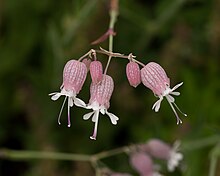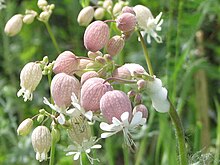|
Silene vulgaris
 Silene vulgaris, the bladder campion[2] or maidenstears,[3] is a plant species of the genus Silene within the family Caryophyllaceae. Native to the Old World, the plant has been naturalized elsewhere, including North America. The young shoots and leaves are edible. DescriptionThe plant can reach 60 centimetres (24 inches) in height, with white-petaled flowers up to 1.8 cm (1⁄2 in) wide.[4] Similar species include S. noctiflora and S. latifolia.[5] Distribution and habitatIt is native to Europe, temperate Asia and northern Africa and has been introduced to other parts of the world, particularly North America,[1] where it is now widespread and a common wild flower in meadows, open woods and fields.[6] Uses The young shoots and the tender leaves are sometimes used as food in some countries of the Mediterranean region.[7] These are considered edible raw before the plant flowers and can be used in salads.[4] The older leaves are usually eaten boiled or fried, sauteed with garlic or in omelettes.[citation needed] Crete and CyprusIn Crete it is called agriopapoula (αγριοπάπουλα) and its leaves and tender shoots are eaten browned in olive oil.[8] In Cyprus it is very widely eaten, so much so that in recent years it has once again been cultivated and sold in shops in bunches. Two of the common Cypriot names are strouthouthkia (στρουθούθκια; [stru'θuθca]) and tsakrithkia (τσακρίδκια; [t͡sa'kriðca]).[9] ItalyIn Italy the leaves of this plant may be used as an ingredient in risotto. It is commonly known as sculpit, stridolo or by the obsolete scientific name Silene inflata, as well as s-ciopetin, grixol in Veneto and nenkuz or sclopit in Friuli and cojet in Piedmont. SpainIn the La Mancha region of Spain, where S. vulgaris leaves are valued as a green vegetable, there used to be people known as collejeros who picked and sold these plants. Leaves are small and narrow so it takes many plants to obtain a sizeable amount. In La Mancha, the leaves, locally known as collejas, were mainly used to prepare gazpacho viudo (widower gazpacho), consisting of flatbread known as tortas de gazpacho and a stew prepared with 'the leaves.[10] Other dishes prepared with these leaves in Spain include potaje de garbanzos y collejas, huevos revueltos con collejas and arroz con collejas. See alsoReferences
External links |
||||||||||||||||||||||||||||||
Portal di Ensiklopedia Dunia
